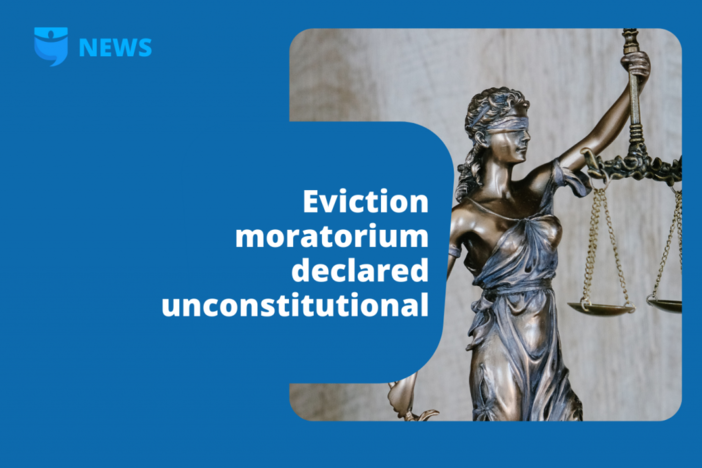Last Thursday, a federal judge ruled that the Center for Disease Control’s (CDC’s) moratorium on evictions is unconstitutional. The judge, John Barker, declined to issue an injunction against the CDC’s rule, but said that he expects that the CDC will respect his decision and withdraw the moratorium.
So far, the CDC has not issued a statement.
One caveat: Even if the CDC order is revoked, many states have similar bans on evictions in place. You can see a list of statewide measures here.
The CDC first issued their order, titled “Temporary Halt in Residential Evictions to Prevent the Further Spread of COVID-19” on September 1, 2020. The CDC’s reasoning for this order was to limit the number of evicted persons crowding in homeless shelters or moving in with friends and relatives, which could worsen the pandemic.
The rule prevents landlords from evicting tenants who meet the following criteria:
Earn less than $99,000 per year, for individuals, or $198,000 for joint filing
Have received a stimulus check or reported no income to the IRS in 2019
Have used their best efforts to obtain government assistance for housing
Cannot pay full rent due to loss of income
Are attempting to make at least partial rent payments
Would be homeless if evicted.
Tenants who meet these criteria are required to sign a declaration, under penalty of perjury, that they meet these criteria.
The order was originally meant to expire at the end of 2020 but was extended until the end of March 2021.
The plaintiffs in the case—Texas Public Policy Foundation and Southeastern Legal Foundation—argued in their lawsuit that the federal government lacks the authority to impose an eviction ban.
Judge Barker agreed, stating “The federal government cannot say that it has ever before invoked its power over interstate commerce to impose a residential eviction moratorium. It did not do so during the deadly Spanish Flu pandemic. Nor did it invoke such a power during the exigencies of the Great Depression. The federal government has not claimed such a power at any point during our Nation’s history until last year.”
Until the CDC or other parts of the federal government respond to Judge Barker’s order, property owners and tenants are left guessing what will happen next.
What now?
The underlying problems that drove the CDC’s actions in 2020 still exist—the virus is still a major public health risk and economic hardship is a reality for many. The question though, is whether an eviction ban is the solution for this complex set of issues.
Many property owners don’t think so. For landlords, this solution unfairly places the burden of the economic crisis on them.
When tenants do not pay rent, property owners still have to make mortgage payments and cover other expenses such as taxes, insurance, and utilities. On average, property owners pay about $10,000 per unit per year for operating expenses on top of their mortgage payments.
When tenants don’t pay rent, owners are often forced to cover costs with their own savings.
According to the U.S. Department of Housing and Urban Development, about half of landlords are "mom and pop" investors who only own a couple properties. These 10 to 11 million individual landlords own on average two units—and many just one. For many of these individual investors, rent income is a vital part of their livelihood. Without rental income, these entrepreneurs face their own financial hardship, which could lead to foreclosure or bankruptcy.
All of these forces combined put individual owners in a difficult situation. Do they take on their tenants’ financial troubles? Or do they evict non-paying tenants to recover lost income?
For tenants, the long-term economic efficacy of the eviction moratorium is uncertain. Those affected can stay in their homes for the time being, but what happens when the ban ends, now or in the future?
Approximately 10 million tenants still owe a cumulative $34 to $67 billion in back rent—and could still face eviction whenever the order expires. The moratorium has done nothing to solve the financial burden of tenants. Rather, it is delaying it.
One solution both state and federal governments are trying is rental assistance programs in the forms of grants and no-interest loans. In theory:
Tenants who meet the criteria would receive the funds they need to stay in their homes
Property owners would be able to cover their expenses
Renters would remain in good standing when the crisis is over—driving downstream impacts on their credit and housing eligibility.
This approach comes at complex issues in a new way, perhaps rendering the eviction moratorium unnecessary. The federal government acknowledged the need and included $25 billion in the last round of stimulus. But that is not enough. According to Moody’s Analytics, that measure, passed in December, will have helped 3.5 million renters get current on rent—but leaves 6.8 million renters owing a cumulative $34 billion in back rent.
Even now, many of the funds distributed to states in December’s stimulus bill have yet to reach renters, as state legislatures are slow to make funds available. This slowness further complicates the situation for people on the ground.
On Saturday, the House of Representatives passed a $1.9 trillion stimulus package that includes another $30 billion in rent assistance—close to Moody’s estimates for the remaining backlog. The bill also includes $10 billion to help homeowners who are behind on mortgage payments, as well as stimulus checks for up to $1,400 per person.
The bill does not include an extension of the eviction moratorium.
By Dave Meyer, BiggerPockets.com

















